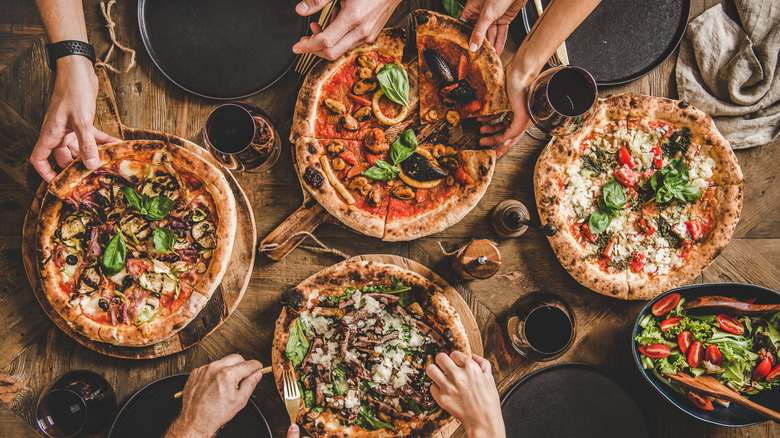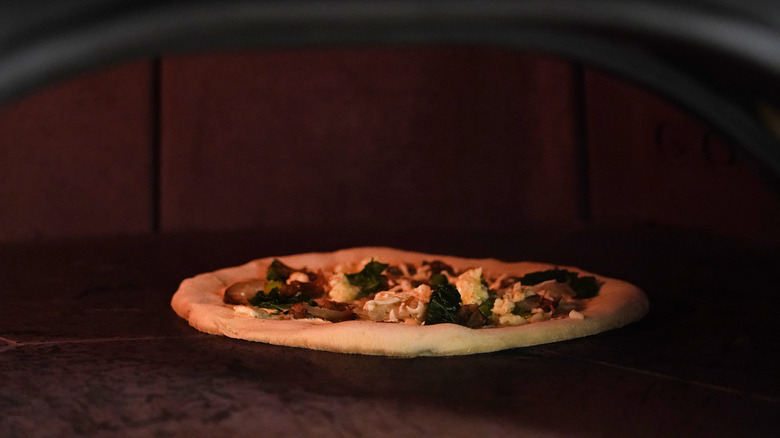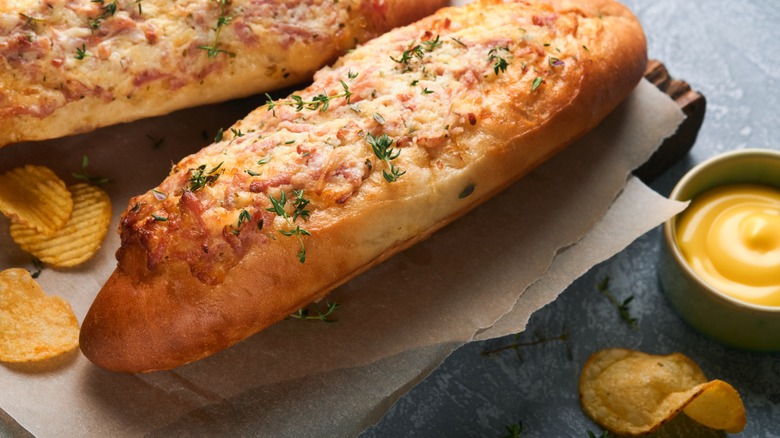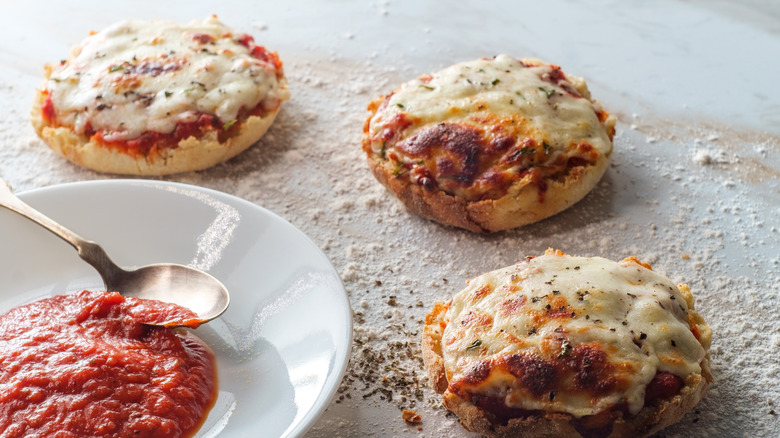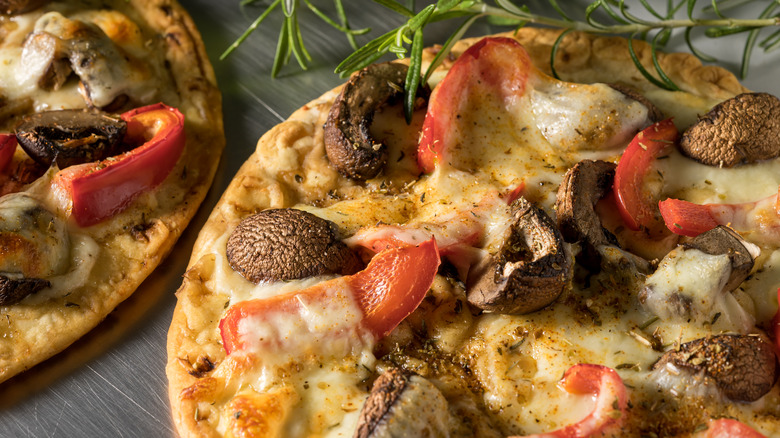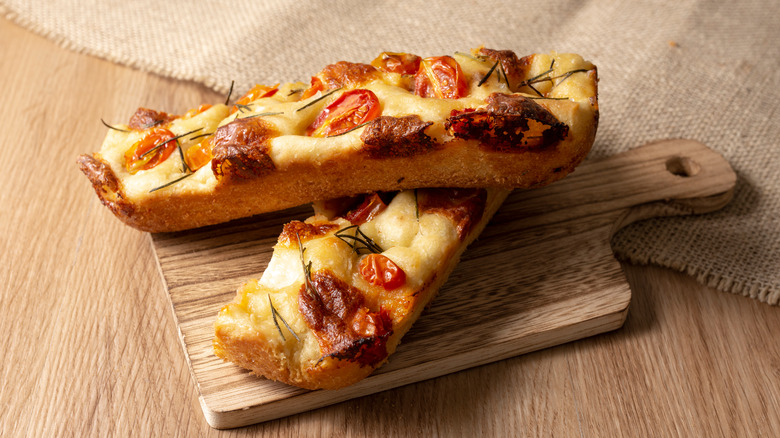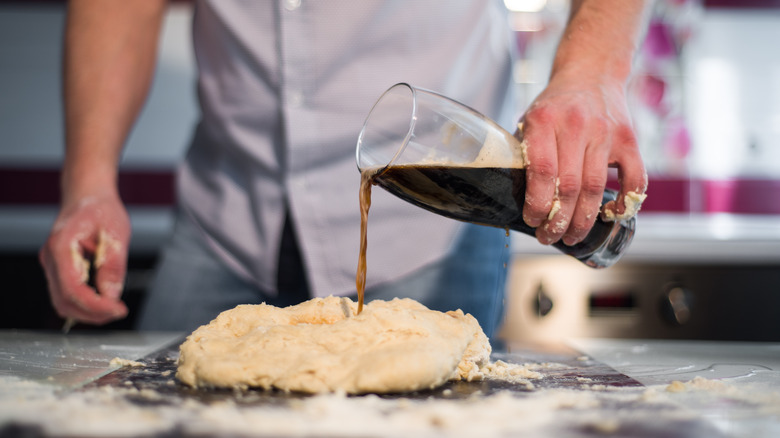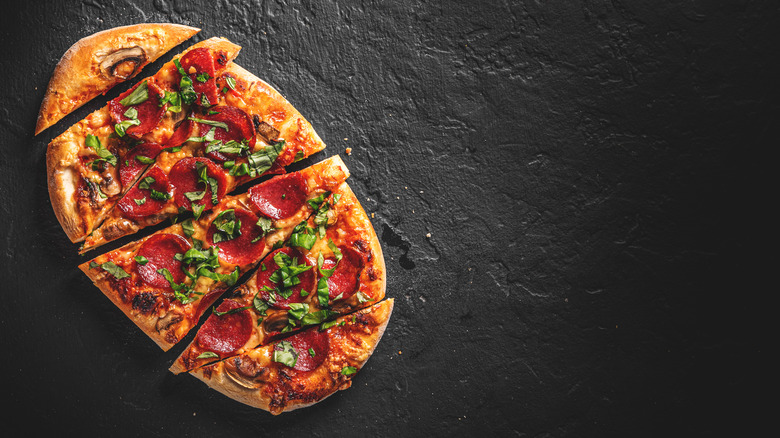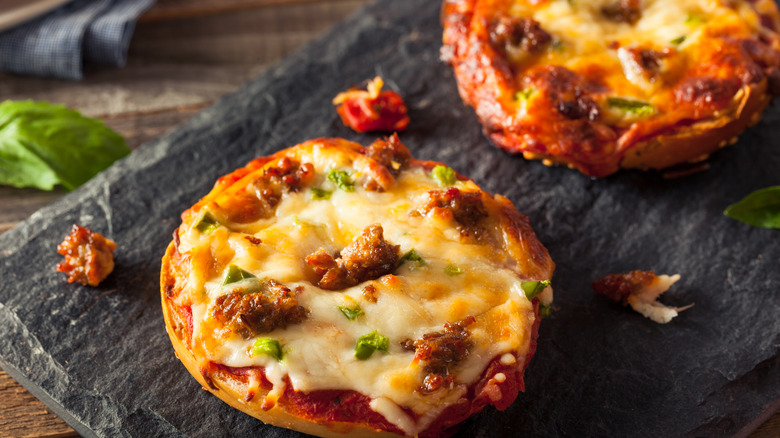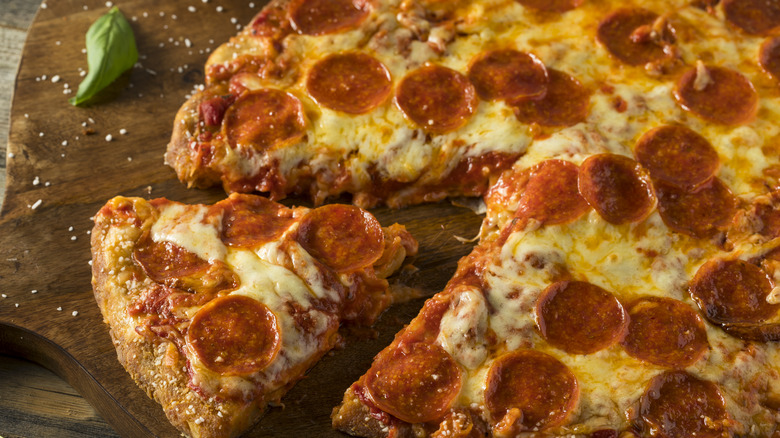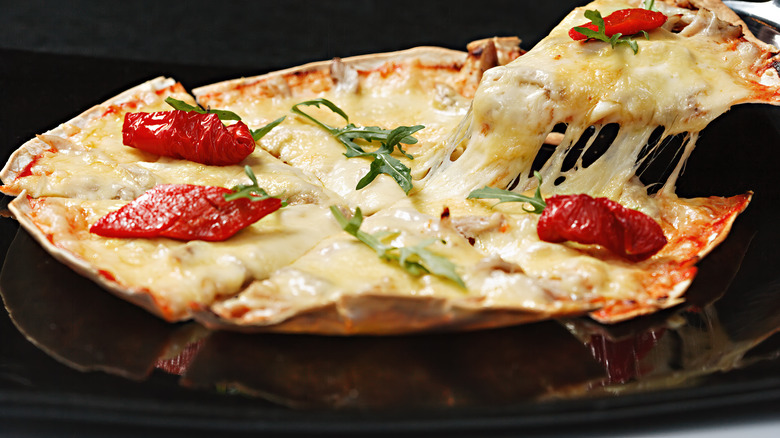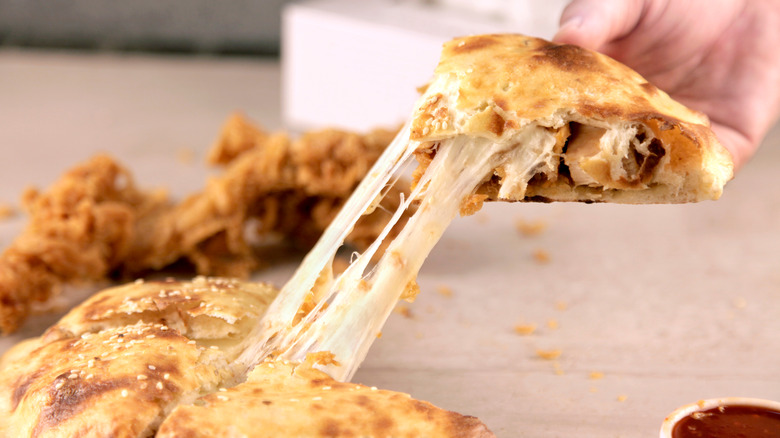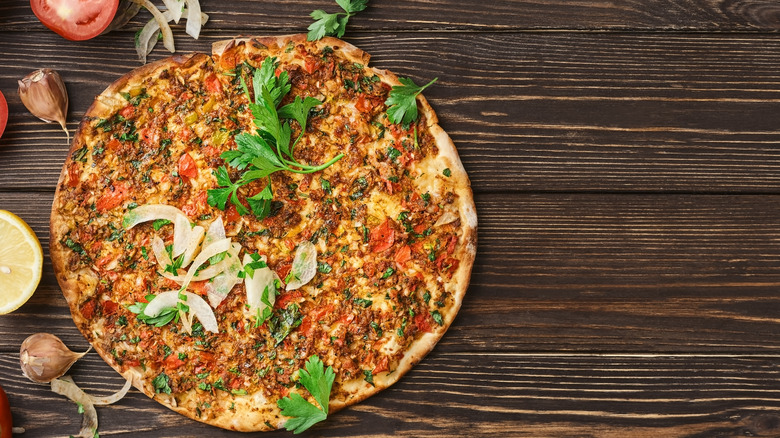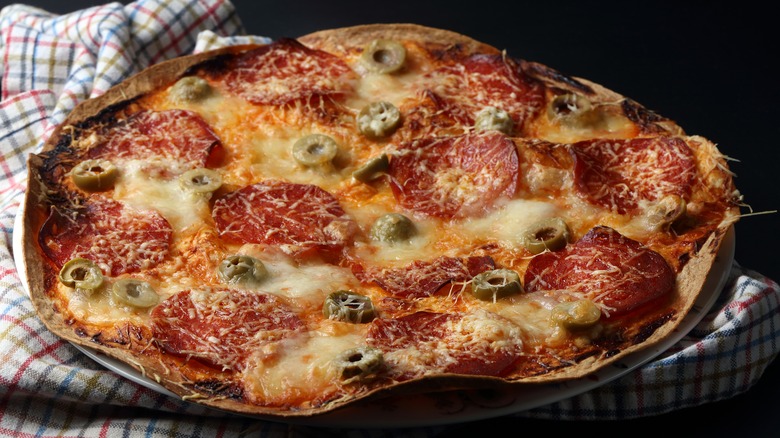13 Types Of Breads To Use For Pizza Crust
As a devoted pizza lover, chances are you've tasted your fair share of classic crusts — from thin and crispy to thick and doughy. While there's nothing wrong with sticking to tried-and-true favorites, venturing out of your comfort zone and experimenting with different types of bread for your pizza crust can be a rewarding and deliciously satisfying experience. Each type of bread brings its own unique characteristics to the table, resulting in a diverse range of pizza experiences.
For instance, a chewy sourdough crust offers a tangy flavor profile that pairs beautifully with robust toppings, while a light and airy focaccia creates a delightful contrast with its rich, olive oil-infused crumb. Some breads like ciabatta rolls, baguettes, and pretzels have a sturdy, airy crumb that stands up well to heavier toppings like meats and cheeses. Their large holes and crisp exterior make for a perfect pizza crust. Flatbreads such as lavash, naan, and pita get delightfully crisp and bubbly when baked, ideal for lighter toppings like fresh vegetables, basil, and olive oil. By experimenting with various breads, you'll broaden your palate and enjoy a multitude of pizza creations.
Sourdough bread
Of all the types of bread that can be used for pizza crust, sourdough bread is arguably the most distinctive. Made from a fermented dough starter containing yeast and lactobacilli, sourdough bread has a characteristic sour and tangy flavor that comes from natural wild yeast fermentation. This long fermentation process also gives the crust a chewy texture. A well-made sourdough pizza crust is a marvel to bite into. The exterior is crisp and slightly charred, offering a satisfying crunch as your teeth sink in. However, the real magic is on the inside: a chewy, airy crumb structure that holds up well against a bevy of toppings.
Beyond taste and texture, sourdough bread also boasts some health benefits. It's easier to digest compared to other breads, thanks to the fermentation process, which breaks down some of the gluten in the dough. Plus, sourdough contains beneficial bacteria, called probiotics, which can aid in gut health. Sourdough pizza crust recipe pairs well with bold and hearty toppings like goat cheese, caramelized onions, roasted mushrooms, and truffle oil. Its strong flavor also stands up well to cured meats like salami, pepperoni, and prosciutto. For the full sourdough experience, use goat milk or bread cheese and finish with a drizzle of olive oil and cracked black pepper.
French bread
Another classic bread that makes for a superb pizza crust is French bread. Crispy on the outside and chewy on the inside, French bread produces a crust that stands up well to heavy toppings while still being easy to bite into. The key to good French bread pizza crust is to use bread that's slightly stale — this will prevent the crust from getting soggy under wet toppings.
The sturdy structure of French bread allows you to pile on multiple toppings. But because the bread can be very crunchy when toasted, avoid toppings that could make the crust difficult to chew, such as anchovies, pineapple, or lots of raw vegetables. When made well and not overloaded, French bread pizza offers a crisp yet pliant crust that is the perfect platform for a variety of classic and gourmet pizzas.
One can't talk about French bread pizza without mentioning its convenience. Since the bread serves as the base, making a pizza becomes as simple as adding your favorite ingredients on top and baking until bubbly and golden. The key to a great French bread pizza lies in how you treat the bread before adding your toppings: To ensure your crust stays crisp and doesn't turn soggy, consider toasting the bread lightly before you add your toppings. This creates a protective barrier between the bread and the sauce.
English muffin bread
If you've never experienced the unique joy of an English muffin pizza, then you're in for a delightful surprise. These miniature pizza delights are not just charming to look at, but they're also an explosion of flavor in every bite-sized piece. They have a characteristic bubbly, uneven surface with lots of nooks and crannies that captures sauce and melted cheese. English muffin bread dough is made from a simple mixture of flour, yeast, salt, sugar, milk, and butter. The secret to getting the distinctive shape and texture of English muffin bread is in how the dough is cooked.
English muffin pizzas are a great quick-and-easy meal option for busy days. They require minimal prep and cook time, making them a lifesaver when you need to put together a tasty dinner in a hurry. Plus, they're not just limited to dinner — try them for breakfast with some scrambled eggs, spinach, and a light sprinkling of cheese for a morning treat. The irregular, chewy texture of English muffin bread makes it a great vessel for holding robust sandwich fillings and burger toppings. As a pizza crust, English muffin bread stands up well to hearty meat and vegetable toppings.
Pita bread
Pita bread, with its pocket-like structure, is an interesting choice for pizza crust. It offers a consistent, even thickness that can be challenging to replicate with hand-stretched dough. This can be particularly helpful for those who are new to pizza-making or simply prefer a uniform crust without the thin spots or overly thick edges that can occur with traditional dough. Plus, pita is typically pre-baked, which means you can have a delicious pizza ready to eat in less time than it would take for your local pizza joint to deliver.
One of the biggest advantages of using pita bread as your pizza crust is portion control. Since pitas are typically smaller than regular pizza, they make for perfectly sized individual servings. This also means that each person can customize their own pita pizza with their preferred toppings, ensuring everyone gets exactly what they want. Pita bread has a mild, nutty flavor and tender crumb that pairs well with any variety of pizza toppings. Its versatility means you can go traditional with marinara and mozzarella or Middle Eastern with lamb, feta, and za'atar spices. Pita also works great for dessert pizzas topped with chocolate, fruit, and whipped cream, or cinnamon sugar.
Focaccia bread
Focaccia bread is a popular Italian flatbread that makes an ideal base for pizza. Thick, hearty focaccia stands up well to heavy toppings and has lots of holes and dimples to trap melted cheese and sauce. Focaccia dough is made from bread flour, olive oil, salt, yeast, and warm water. The secret to light, airy focaccia is in handling the dough gently during rising and dimpling it with your fingers before baking.
The versatility of focaccia makes it suitable for both traditional and non-traditional pizza toppings. For instance, a classic margherita topping of fresh tomatoes, mozzarella, and basil pairs beautifully with the bread's inherent savory notes. On the other hand, you could also try something a bit different, like a Mediterranean-inspired pizza with feta cheese and olives or a simple garlic focaccia pizza recipe that you can make in 28 minutes. Focaccia's rough, rustic appearance and hearty texture make it perfect for casual get-togethers.
Top focaccia generously before baking for a shareable appetizer or add your favorite pizza toppings for a satisfying main course. The crisp yet chewy crust and perforated interior of focaccia bread capture the vibrant flavors and juices of whatever you put on top.
Beer bread
If you're a beer lover and a pizza aficionado, why not combine your two passions and explore the fascinating realm of beer-bread pizzas? Beer bread gets its distinctive taste and texture from the yeast and malted barley used to make beer. The yeast helps the bread rise, giving it an airy, chewy crumb that stands up well to heavy pizza toppings. The malted barley adds a slight malty sweetness and richness that pairs perfectly with savory pizza flavors.
Beer bread is also extremely simple to make. You only need a few basic ingredients — beer, flour, sugar, salt, and baking powder. Just mix everything together, knead briefly, and bake. No proofing yeast or long rise times required. For a quick homemade pizza night, you really can't beat the simplicity of a beer-based pizza dough.
The high starch content of beer helps the crust get delightfully crisp when baked at high pizza temperatures. A crisp yet chewy crust is ideal for holding piles of gooey cheese and your favorite toppings. And the sugars in beer cause the crust to brown beautifully in the oven. There's nothing quite like a freshly baked, golden brown pizza crust hot out of the oven. The beer also imparts a subtle hoppy, malty aroma to the crust that enhances the overall pizza experience. Each bite smells as good as it tastes.
Flatbread
Flatbread is simply a primitive type of bread that is flat, rather than light and airy. It's made from a basic dough of just flour, water, salt, and sometimes oil or yogurt. The dough requires no leaveners like yeast, so it's very fast to make and requires no rising time. Flatbread has been around for thousands of years and is still popular in many cuisines today. Because of its simplicity, flatbread pizza crust has a pleasantly chewy, slightly sourdough-like quality and a rustic, handmade appeal. It's the perfect canvas for artisanal toppings and homemade sauces.
What sets flatbread pizzas apart from traditional pizzas is their thin, crispy crust. This lighter crust puts more emphasis on the toppings, letting their flavors shine through. Whether you're a fan of classic pepperoni and cheese or prefer more unique toppings like roasted vegetables and goat cheese, a flatbread crust provides the perfect canvas for your pizza artistry.
Baking flatbread pizza at a very high temperature, around 450 degrees Fahrenheit, will yield the best results. The intense heat causes the crust to puff up and blister, creating airy pockets that are perfect for trapping cheese and oils. Brush the crust with oil or garlic butter before adding toppings and it will get nicely browned and crisp at the edges.
Bagels
Bagels have an airy, yeasty quality that stands up perfectly to heavy pizza toppings. They get delightfully crisp and browned when baked at high temperatures, while maintaining a chewy interior. And their flavor is mildly sweet, providing the perfect neutral canvas for savory pizza sauces and toppings. Bagels are boiled before baking, which gives them their distinctive dense, chewy crust. Using bagels as pizza crusts is a great way to make use of day-old bagels that have gone slightly stale. The baking process re-crisps and revives the crust, turning stale bagels into something entirely delicious.
To make bagel pizzas, simply top split bagel halves with your favorite sauce and toppings. Everything bagels pair well with pesto and veggie toppings or alfredo and chicken. Asiago cheese bagels are ideal for white pizzas. For a sweet and savory treat, top plain or egg bagel halves with Nutella, bananas, and marshmallows. The options are endless!
Bagel crust is also a great option if you want to make individual-sized pizzas. Use one split bagel half for each mini pizza. Set out sauces and a variety of toppings and let everyone top their own bagel base. Bagel pizzas also work great on the grill for appetizers at your next BBQ.
Pretzel
Pretzels have a long history dating back to medieval times, appreciated for their unique baking method which involves boiling the dough in an alkaline solution before baking. This process gives pretzels their distinctive shiny crust and dark, rich color. It also leads to a unique flavor profile — slightly malty and a touch bitter with a delightful underpinning of saltiness that perfectly complements the flavors of pizza.
Creating a pretzel crust pizza involves using pretzel dough, shaping it into a pizza crust, boiling it briefly in a baking soda solution, then topping and baking as you would a regular pizza. The result is a crust that marries the chewy, slightly dense texture of a pretzel with the bubbling cheese and savory toppings of a pizza. If you're a fan of the soft pretzel's flavor and texture, this pizza base will be right up your alley. One of the highlights of pretzel crust pizza is the way its flavors play with traditional pizza toppings. The slight bitterness of the crust forms a pleasing contrast with the sweetness of pizza sauce and the richness of the cheese, while its underlying saltiness provides a satisfying counterpoint to toppings like veggies or lean meats.
Tortilla
Chances are, you've encountered tortillas. But have you ever considered using a tortilla as a pizza crust? Soft or crispy, corn or flour, tortillas make an ideal foundation for creative pizza toppings. They require no preparation and need only heating before serving. Simply top tortillas with your favorite cheeses and toppings, bake briefly and enjoy your Mexican pizza recipe.
The type of tortilla you choose can affect the flavor of your pizza. Flour tortillas get deliciously crisp and chewy when baked, while corn tortillas remain pliable with a slight crust. Either works well for tortilla pizzas, depending on your preference for a soft or crisp crust. Flour tortillas pair nicely with robust meats and cheeses. Corn tortillas are ideal for Mexican-inspired toppings like black beans, salsa, and avocado. Tortilla pizzas also shine in the flavor department. The thinness of the tortilla allows the toppings to take center stage, providing an excellent balance of flavors. Furthermore, because the tortilla crisps up so quickly in the oven, you get a delightful contrast of textures between the crunchy crust and the soft, melted cheese.
Naan
Naan is a popular Indian flatbread usually made with white flour, yeast, water, and yogurt or milk. Griddled in a tandoor oven, naan bread has a characteristic soft, chewy texture and slight char from wood-fire cooking. Although traditionally paired with curry or used as a wrap for kebabs and other grilled delicacies, naan is gaining popularity as a base for more unconventional dishes, pizza being one of them. To make naan pizza crust, you can use your oven or a cast iron skillet to mimic the high heat of a tandoor.
One of the best features of naan pizza is the thickness of the naan bread. It's thicker than a tortilla but thinner than traditional pizza dough, providing a crust that's just right: not too heavy, but substantial enough to hold a generous amount of toppings. Flavor-wise, naan bread offers a slightly tangy and buttery taste, creating an exceptional base for all sorts of toppings. The combination of the naan's distinct flavor with the familiar taste of pizza ingredients is truly exceptional, leading to a pizza experience that's out of the ordinary. And, for an added kick, you can opt for flavored naan varieties like garlic or onion. The chewy naan crust has a robust, smoky flavor from wood-fire cooking that pairs well with vibrant Indian spices.
Lahmacun bread
Lahmacun, sometimes referred to as Turkish pizza, is a traditional dish from Turkey. It involves a thin round of dough that's topped with minced meat, vegetables, herbs, and spices before being baked to perfection. It's typically rolled up and eaten like a wrap, but it also makes an excellent base for a pizza with a twist. Lahmacun bread, much like a tortilla, is thin and crisp, providing a light and delicate crust for your pizza. What sets it apart, though, is its unique flavor. The traditional toppings used in lahmacun — typically a mix of minced lamb or beef, tomatoes, peppers, onions, and a variety of herbs and spices — are mixed into the dough, infusing it with a rich, savory flavor that elevates your pizza to a whole new level.
Lahmacun bread is simple to make at home using just a few ingredients: flour, yogurt, olive oil, salt, and spices like dried mint or red pepper. The dough requires no yeast, so there's no rising time, and you can have fresh lahmacun bread ready in under an hour. Brush rounds of the dough with more olive oil, top as desired, and bake briefly until the crust is crisp and the toppings are hot. An exotic change from regular pizza, lahmacun is sure to satisfy even the most adventurous eaters.
Lavash bread
Lavash bread is a thin, soft bread that is traditionally baked in a tandoor or on a saj griddle. It's prized for its simplicity, which allows it to pair perfectly with a myriad of flavors, making it an excellent base for a creative pizza. Its mild nutty flavor pairs nicely with everything from traditional marinara and cheese to Mediterranean lamb and fig. You can also top lavash with Nutella, hazelnuts, and fresh berries for dessert pizza. However you choose to top it, lavash bread holds up beautifully under heavy toppings while getting perfectly crisp in a hot oven. Constructing a lavash bread pizza is as easy as pie. You start with a piece of lavash bread, add your pizza sauce, sprinkle on your cheese of choice, and finish off with your preferred toppings. A few minutes in the oven will yield a crispy, delicious pizza that is uniquely yours.
One of the standout features of lavash bread pizza is the texture of the crust. It's thin, light, and becomes delightfully crisp when baked. This crunchiness offers an exciting contrast to the oozy, melted cheese and flavorful toppings, making every bite a symphony of textures. Lavash bread has a slightly nutty, grainy taste that adds an extra layer of complexity to your pizza. Plus, the thinness of the bread allows the flavors of your toppings to shine, resulting in a pizza that's packed with taste from edge to edge.
